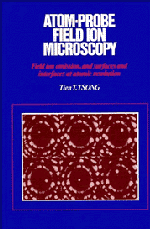 Atom-Probe Field Ion Microscopy
Atom-Probe Field Ion Microscopy 4 - Applications to surface science
Published online by Cambridge University Press: 30 October 2009
Summary
Atomic structure of solid surfaces
The field ion microscope, when operated at low temperatures, has a resolution of better than 3 Å if the tip radius is less than a few hundred Å, which is sufficient to resolve the atomic structures of most solid surfaces. For closely packed surfaces, atomic spacings are usually less than 2.8 Å. But even such surfaces can be resolved if the tip temperature is below 20 K, the tip radius is less than 150 Å and the plane size is also very small so as to contain no more than, say, a few tens of atoms, as can be seen from images shown in Fig. 2.32. For a material to be able to be imaged in the field ion microscope, however, the low temperature evaporation field of the material has to be comparable to or higher than the best image field of the image gas used for the field ion imaging. In field ion microscopy, to eliminate the problem of contaminating a field evaporated clean surface and of destroying the surface by a field induced chemical etching from chemically reactive gases, one almost always uses an inert gas for the field ion imaging. The ionization energies of inert gases are higher than most chemically reactive gases, thus requiring a higher field ionization field, or an image field. This image field can serve to protect the clean, field evaporated emitter surface from contamination and from a field induced chemical etching by chemically active residual gases inside the vacuum chamber.
- Type
- Chapter
- Information
- Atom-Probe Field Ion MicroscopyField Ion Emission, and Surfaces and Interfaces at Atomic Resolution, pp. 166 - 317Publisher: Cambridge University PressPrint publication year: 1990
